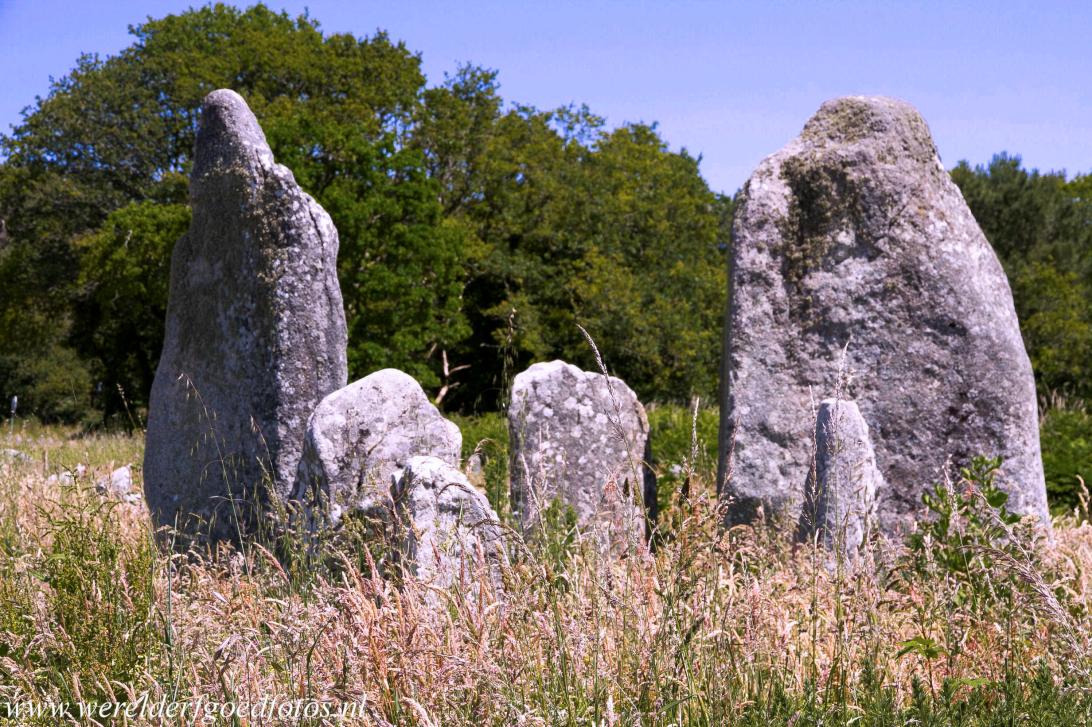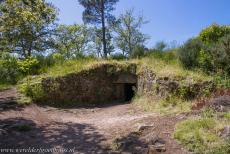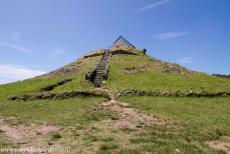The megaliths of Carnac are located in the moors and woods around Carnac, a small town in the Morbihan department of Brittany, France. The megaliths of Carnac are the largest collection of megalithic standing stones in the world. They were erected during the Neolithic period, about 3300 years before BCE, but some of the stones are even older, probably about 4800 BCE. The more than 3000 standing stones were erected by the pre-Celtic inhabitants of Brittany. Over the centuries, many of the standing stones were removed and used for building material. It is estimated that there were once about 11.000 standing stones. The stones were erected in rows, alignments. The stones were hewn of local granite. There are three major groups of alignments: the Ménec Alignments, the Kermario Alignments and the Kerlescan Alignments. The Petit-Ménec Alignments are located in the woods near the village of Trinité-sur-Mer. There are also several tumuli scattered around Carnac, among them the tumulus of Saint-Michel and the Moustoir tumulus. There are also a number of dolmen, among them the of Er-Roc'h-Feutet Dolmen, the Kercado Dolmen and the Kerlescan Dolmen. The Manio Quadrilateral is situated near the Giant of Manio, the highest standing stone in Carnac. The megaliths of Carnacc are located near the south coast of Brittany, a peninsula south west of Normandy and north west of the Loire Valley. Nowadays, it is not allowed to walk between the alignments, they are fenced in. The Alignments of Carnac are about 1,000 years older than Stonehenge in Great Britain. More information about the megaliths of Carnac can be found at the Carnac Prehistory Museum and the Visitor Centre next to the Ménec Alignments. The Megaliths of Carnac and of the shores of Morbihan became a UNESCO World Heritage in 2025.
www.werelderfgoedfotos.nl © Copyright World Heritage Photos Classic Car Road Trip

The Kermario is one of the megalithic sites in Carnac. The megaliths of Carnac are located in the moors and woods around Carnac, a small town in the Morbihan Region in Brittany, France. The megaliths of Carnac were erected during the Neolithic period, they are the largest collection of megalithic standing stones in the world. Most of the granite megaliths were erected somewhere between 4,800 and 3,500 BC. The stones were hewn from local granite, the height of the stones vary considerably. The largest megalith is more than six metres high.

The Kermario is one of the megalithic sites in Carnac. The megaliths of Carnac are located in the moors and woods around Carnac, a small town in the Morbihan Region in Brittany, France. The megaliths of Carnac were erected during the Neolithic period, they are the largest collection of megalithic standing stones in the world. Most of the granite megaliths were erected somewhere between 4,800 and 3,500 BC. The stones were hewn from local granite, the height of the stones vary considerably. The largest megalith is more than six metres high.

Megaliths of Carnac: The Ménec Alignments, rows of standing stones, stretches over one km in length. The Ménec consists of 1050 standing stones. One of the standing stones is 3.50 metres high and is called the Géant du Ménec, the Ménec Giant, this menhir was probably erected before the alignments were built. The Visitor Centre 'Maison de Mégalithes' is located next to the Ménec Alignments, through images, it explains the history of the megalithic structures in Carnac and elsewhere in the Morbihan region.

Megaliths of Carnac and the Morbihan region in Brittany: The Ménec Alignments consists of eleven parallel lines of standing stones. The largest stones are about four metres high and are located at the wider, western end. Along the entire length of the alignment the stones become smaller, about 0.6 metres in height, before growing in height again towards the eastern end. At the Western end are the remains of a stone circle, a cromlech, of 71 blocks, and at the eastern end, there are the remains of another cromlech.

Megaliths of Carnac in the Morbihan Region: The Kermario Alignments are the most impressive of the Megaliths of Carnac due to the lenght of the stone rows and the height of the megaliths. Kermario consists of 1029 standing stones, divided on ten parallel lines of standing stones. The Kermario Alignments stretches over 1128 metres in length. The Kermario Alignments are about 96 metres wide on the west side and 36 metres on the east side, they point to a large menhir.

The megaliths of Carnac and the Morbihan Region in Brittany: The Kermario Dolmen is situated at the southwest corner of the Kermario Alignments. The granite structure was built as a burial chamber, the granite stones originally were covered by an earth mound. The dolmen is older than the Kermario Alignments. There are several dolmen and tumuli scattered around Carnac. There are more than 550 Neolithic sites on the shores of the Morbihan, the most renowned are the Carnac Alignments.

Megaliths of Carnac: The Giant of Manio is the highest standing stone in Carnac and one of the highest in the Morbihan region. The menhir is 6.50 metres high. It could have been placed here to indicate the presence of a nearby burial mound. Situated nearby the Giant of Manio stands the Manio Quadrilateral, the one-metre high granite stones are placed at ground level in the shape of a rectangle, it probably marked the location of tumulus or tomb that no longer exists. The Giant of Manio is a prominent landmark in Carnac and the Morbihan region.

Megaliths of Carnac, Morbihan Region in Brittany: The Tumulus de Kercado is a chambered tomb dating from around 4800 BCE. The single chamber is reached through a low passage. It is one of the oldest monuments in Carnac and in the Morbihan region. At the base, the tumulus is 40 metres in diameter. A menhir is standing on top of the tumulus. The tumulus is surrounded by the remains of a stone circle, one menhir is standing a few metres from the entrance of the tumulus. Nummerous artifacts were found in the chamber, such as human and animal teeth, fragments of pottery, paerls and beads of unique bluish nephrite jade.

Neolithic Carnac, Morbihan Region in Brittany: The Chapel of Saint Michel on top of the Tumulus Saint Michel. The first chapel was built in 1664, and rebuilt on the same design around 1813, and again in 1925. The Tumulus Saint Michel was built on the highest point in Carnac, it offers amazing views over the entire Carnac area and Quiberon Bay. At the foot of the tumulus stands the Fountain of Saint-Michel. Women whose husbands were at sea came here to pray for a safe journey. The Tumulus of Saint Michel is the most prominent tumulus in Carnac and the shores of the Morbihan.

Megaliths of Carnac and the Morbihan Region in Brittany: The Tumulus Saint-Michel, at the top the Chapel of Saint-Michel. The Tumulus Saint-Michel was built around 4500 BCE. The imposing mound is 12 metres high, 125 metres long and 60 metres wide, it is the largest grave mound, or tumulus, in continental Europe. The tumulus was excavated in 1862, a dolmen was discovered, in the middle was a small burial crypt surrounded by fifteen small stone chests. The burial crypt contained several artifacts, among them stone axe-heads, flint tools, beads and the mineral sillimanite. The objects are now on display in the Carnac Prehistory Museum.
